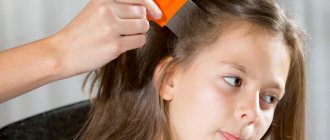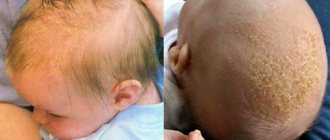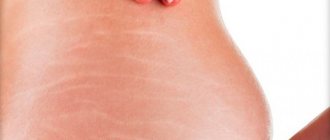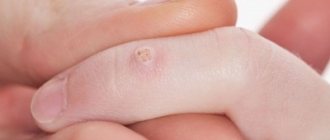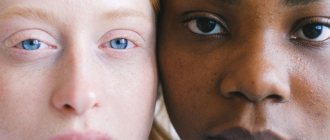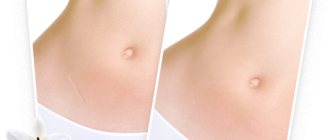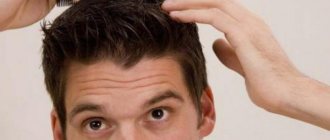What are crusts on the head?
The crusts look like dense scaly growths on the child's head. Sometimes you may also notice redness or a rash. Crusts can form on the face (including the ears, eyelids and nose) and in the groin area. This is not a contagious condition and usually does not cause itching, pain or scarring.
The crusts can be confused with eczema or dandruff; the pediatrician will be able to accurately diagnose. Unlike eczema, crusts usually do not cause discomfort or itching.
Sometimes crusts on the head can appear in children older than 3 months, and in those who have already begun to walk. Usually the crusts persist for several months and then disappear on their own. In some cases, scabs may persist for a year or longer, and it may be necessary to use a medicated shampoo or cream.
Seborrheic dermatitis: consequences
Without treatment, seborrheic dermatitis can become chronic. If dermatitis itself has become chronic, then its relapses without control and treatment will often occur under the influence of external and internal factors.
Dermatitis can develop into an eczematous state, constantly accompanied by dandruff. Often, seborrheic dermatitis causes severe hair loss and baldness. Serious consequences and complications include external and otitis media if dermatitis developed in the parotid area. Severe forms of acne are also possible.
How to get rid of seborrheic dermatitis of the scalp (hairy part): how to treat it and can it be cured?
The right decision would be to consult a doctor so that he can select medications and ointments according to the individual characteristics of the body and the course of the disease. Contact a dermatologist
necessary, even if the symptoms are not clearly expressed. Any skin disease must be taken under control in the early stages.
Can seborrheic dermatitis be cured?
This disease is chronic, but not contagious. Therefore, its treatment is rather aimed not at completely getting rid of the disease, but at protecting the patient from frequent relapses and serious consequences. If you follow all the doctor’s instructions and simple rules of prevention, then dermatitis may not bother you at all.
Medical specialists will conduct an examination and prescribe an effective course of treatment, selected individually for the patient according to the clinical picture, as well as age and gender.
Seborrheic dermatitis of the face, head and body: symptoms
This skin disease has quite characteristic symptoms, and recognizing it is not so difficult, but only a doctor will give you an accurate diagnosis at your appointment.
The disease is characterized by the following symptoms:
- irritation, redness and itching of the skin;
- the appearance of white or yellow scales;
- peeling of varying degrees of intensity;
- the appearance and widespread distribution of acne;
- soreness of the skin when touched and in contact with clothing.
The resulting scales and peeling create the effect of a crust, under which there is reddish, weeping skin. And the longer dermatitis is left untreated, the more the spots spread and the larger the size they acquire.
Since the spots can be located on the face, seborrheic dermatitis creates not only physical, but also psycho-emotional discomfort. The spots should not be scratched, otherwise secondary infection may cause the development of eczema.
Whatever symptoms accompany seborrheic dermatitis, mild or intense, you should not delay a visit to the doctor. At the medical office, you can make an appointment with a dermatologist at a time convenient for you.
Seborrheic dermatitis of the scalp and face: causes
There are no exact reasons for the appearance of symptoms of the disease, but there are factors that provoke both infection and the spread of unpleasant flaky spots. The main one is the fungus malassezia furfur.
Other causes of dermatitis include:
- malfunction of the pituitary gland, gonads, adrenal glands, as well as the endocrine and nervous systems, which control the production of sebum and the functioning of the sebaceous glands;
- genetic predisposition;
- age: the disease often affects young people during puberty;
- severe stress and constant nervous tension;
- poor nutrition and bad habits;
- hormonal imbalances;
- thyroid disorders;
- lack of vitamins and minerals;
- disorders of the gastrointestinal tract;
- complete lack of physical activity and insufficient exposure to fresh air.
For what reason the symptoms of seborrheic dermatitis arose in a child or adult, only a specialist can know. And accurately determining the causes is an important point in order to select the correct and effective treatment.
As mentioned above, treatment should be selected by a doctor based on the tests and studies performed. In order for the doctor to make a diagnosis and refer you for examinations, you must first make an appointment with the doctor.
The staff of our medical center provide comfort to each patient, listening to his requests and wishes, but taking into account all the features and stage of development of the disease. Often, patients who have overcome seborrheic dermatitis now live without exacerbations or relapses.
Initial appointment
Treatment begins with the first consultation with a doctor and examination of the patient. At the first consultation, the doctor finds out what could lead to the appearance of flaky spots and asks about the patient’s lifestyle. The doctor also analyzes complaints.
Based on the examination and the first data, the doctor gives a referral for tests and examinations. And only after all the tests and laboratory tests are ready, the doctor prescribes treatment and draws up a plan for individual visits for the patient.
Diagnostics
The medical department provides comprehensive diagnostics and treatment of any skin diseases. As examinations, methods such as specialized expert clinical and clinical-biochemical microscopy, as well as dermatoscopy and cultural diagnostics are used.
Tests for seborrheic dermatitis:
- laboratory tests of skin scrapings (microscopic and mycological examination for pathogenic fungi);
- hormonal analysis;
- diagnostic biopsy.
In some cases, consultations with an endocrinologist, gastroenterologist and psychotherapist are prescribed. Consultations with the latter are prescribed if the patient has serious psychological problems due to this disease. Each specialist prescribes tests and examinations to make it clear how to get rid of seborrheic dermatitis and avoid relapses.
Repeated appointment
At the follow-up appointment, the doctor prescribes a treatment regimen based on the results of the examination, depending on the individual characteristics of the patient (age, gender, etc.) and the location of the dermatitis. If no positive dynamics are observed during treatment, the doctor prescribes additional examinations and adjusts the selected treatment regimen.
Dermatitis on the face
This type of localized dermatitis is treated in different ways, but always delicately, since the disease is often painful for the patient. It is very important for the patient to follow a diet for seborrheic dermatitis on the face, that is, absolutely exclude seasonings, chocolate, various canned foods and pickles from the menu.
In this case, corticosteroids and other medications are often prescribed to relieve symptoms. During the cold season, it is very important to strengthen the immune system not only with vitamin complexes, but also with proper physical activity.
How to treat seborrheic dermatitis of the scalp?
To do this, the doctor selects a comprehensive treatment, which includes:
- the use of shampoos with special substances that can correct the secretion of sebum and eliminate its excess (shampoo for seborrheic dermatitis on the head is selected individually);
- prescription of antifungal drugs;
- compliance with the prescribed diet, that is, eating foods rich in vitamins A, B, C, as well as selenium and zinc;
- undergoing physical procedures: cryomassage, darsonvalization and ultraviolet therapy.
All this allows you to eliminate symptoms and control the factors that provoke the development of the disease.
Control reception
21–30 days after completing the course of treatment for seborrheic dermatitis, the doctor schedules a follow-up appointment to assess the patient’s condition and how effective the selected prevention and disease control measures are.
Treatment result
The disease is controllable, and complete relief from relapses and serious consequences is possible, but the patient must strictly follow the doctor’s recommendations for treatment and prevention.
The duration of treatment, like the regimen itself, is individual and is determined at a doctor’s appointment, and can also be adjusted as treatment progresses. If necessary, family members of the patient can also undergo examination.
Prevention
The simplest rules for preventing skin diseases are strengthening the immune system (especially in winter), properly selected physical activity and only suitable cosmetics, including ointments for seborrheic dermatitis. In addition, it is necessary to follow a diet that includes the use of:
- pure water and freshly squeezed juices, as well as natural herbal infusions and decoctions;
- lean dietary meat;
- lean fish;
- a large number of vegetables on the menu when following a diet for seborrheic dermatitis: pumpkin, zucchini, squash, cabbage, asparagus, etc.;
- some dairy products (cottage cheese, kefir, yogurt, etc.);
- berries, as well as fruit drinks and compotes made from them.
It is necessary to exclude fried and fatty foods, marinated and smoked foods, fast food, citrus fruits, mushrooms and caviar from the diet.
Your doctor will tell you more about nutrition for seborrhea. You can make an appointment with a specialist through the online form on the website or by calling the phone number listed on the page.
Why do crusts appear on the head?
The exact cause of scalp crusts is unknown, but experts do not attribute the appearance of crusts to allergies or poor hygiene. One factor may be the transfer of mother's hormones to the baby during pregnancy, which causes excess sebum to form in the sebaceous glands and hair follicles. Another factor may be a type of malassezia fungus that lives in the sebum along with bacteria.
Washing your baby's hair daily with a mild baby shampoo will help prevent crusting.
How to remove milk crusts quickly and comfortably?
Authors : Ulyanova Alexandra
As an advertisement
What are “milk crusts”?
Seborrheic dermatitis, gneiss or simply “milk crusts” are white or yellowish sebaceous scales that appear on areas of the skin rich in sebaceous glands: scalp, ears, face, upper third of the chest and back, inner thighs. They usually appear in the first 10 weeks of life.1
Why does my child have scabs?
This problem occurs in about 70% of children and usually goes away in a few weeks or months.
This is usually due to excessive activity of the sebaceous glands due to the presence of maternal hormones in the child’s body. 1 Therefore, you should not worry that your baby was so unlucky.
Do they need to be removed?
This is not dangerous for the baby, but the skin must be cleaned of crusts to prevent infection. In addition, the appearance of the crusts is not very attractive!
What if there are only a few crusts?
If there are very few crusts, they are small and loose, then washing your hair daily with a special foam shampoo for newborns will be sufficient. This foam contains climbazole and salicylic acid in a concentration approved for use in children's shampoos, which limit the growth of bacteria and help soften milk crusts.
How to remove crusts using oil?
To get rid of milk crusts, they traditionally use this method: the crusts are softened with warm boiled vegetable oil and combed out with a comb. If there are a lot of crusts, then it becomes almost a military operation. Heat the sunflower oil, make sure it is not too hot, apply it to the baby's head and put a cap on top. This procedure, of course, stains your hands, diapers, and clothes with oil. After a few hours, wash the head and start combing, being careful not to scratch the baby’s skin or damage the hair follicles with the comb. This procedure must be repeated regularly, as crusts may reappear over time. Agree, this procedure is not pleasant!
Is it possible to remove crusts quickly and without combing?
Fortunately, science is moving forward, and there are modern and safe ways to get rid of milk crusts.
Mustela scalp cream for “milky crusts” will help cope with the problem in an average of one week. And you don't have to comb it out with a comb!
Applying the cream is more convenient and easier than regular oil: it is non-sticky with a milky texture, and has a thin applicator nose. Hands, clothes and towels - everything remains clean.
How does milk crust cream work?
The cream acts not only on the crusts themselves, but also on the cause of their occurrence, regulating the production of sebum. The cream contains effective softening components, such as borage oil, which also has moisturizing properties.
Apply the cream to the crusts, massaging lightly, leave overnight and rinse off the next day. The crusts will come off easily during washing. The cream works faster and more efficiently - on average, within seven days the crusts disappear completely. 2
For better results, after applying the cream, it is better to wash your head with Mustela foam shampoo for newborns and use it instead of regular shampoo to minimize the risk of crusts. The texture of the foam is very delicate and consists of 99% ingredients of natural origin.
When should you see a doctor?
If crusts appear, as well as if the skin condition worsens, redness or itching appears, you should consult a pediatrician.
Clinical recommendations “Seborrheic dermatitis in children.” Union of Pediatricians of Russia, 2016. https://www.pediatr-russia.ru/sites/default/files/file/kr_sebder.pdf
According to the results of a test involving 60 children who used the cream for 2 weeks, 63% of respondents completely disappeared milk crusts on average within 6.6 days, the remaining 37% showed an improvement in their condition. Clinical studies Cleanreal D1516/TC091/1042F4
published 05/04/2019 14:11 updated 05/04/2019
How to remove crusts on a child's head?
Thick crusts can be difficult to remove, try the recommended procedures:
- Once a day, when you bathe your baby, wash his hair with mild baby shampoo. Ask your pediatrician to recommend a shampoo for scalp crusts.
- Gently comb out the flakes with a comb or soft scalp brush and then rinse off the loose flakes with water. Do not rub or scratch your skin.
- You can also use baby oil or vegetable oil. Before combing out the scales, lubricate the child's head with oil; it will moisturize the skin and help loosen the scales on the head, making them easier to remove. After the procedure, wash the baby's head with shampoo.
How to get rid of crusts on your face?
When dermatitis is localized on the face, the main rule remains the same: you should not pick off the scales with your fingernails or other sharp objects. Such actions can injure delicate skin and cause infection.
It is necessary to moisten the crusts with oil before each bath, and then carefully rinse with a delicate shampoo. Care must be taken to ensure that shampoo with oil residue does not get into the child’s eyes.
Since it is very problematic to comb out crusts from the face with a brush, it is recommended to simply wipe the affected area with a piece of clean flannelette cloth with slight pressure. The key factor in the fight against seborrheic dermatitis on the face is the regularity of procedures, and not the intensity of each of them. In the vast majority of cases, it is possible to avoid the formation of significant growths and completely get rid of unpleasant symptoms by 4-5 months of the baby’s life.
When should you see a doctor?
Consult a doctor if shampooing does not help and the skin condition worsens and crusts cover large areas of the body, spreading to the child's face and body. The doctor may prescribe a special shampoo or cream, as well as antifungal treatment. You may also hear about natural or folk remedies to get rid of scalp crusts, but before using them, you should consult your doctor.
Scabs on a newborn's head may frighten parents at first, but over time they will disappear on their own. By
